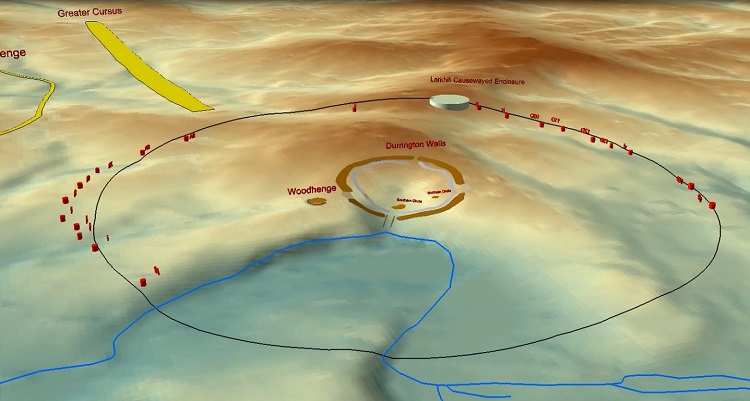New circle discovered near Stonehenge

Stonehenge may be one of the best-known archaeological sites on Earth, but a team of archaeologists are celebrating the discovery of a major new prehistoric monument only a short distance away from Stonehenge.
Recent fieldwork and analysis have revealed evidence for twenty or more massive prehistoric shafts, more than ten metres in diameter and five metres deep. These shafts form a circle more than two kilometres in diameter which encloses an area greater than three square kilometres around the Durrington Walls henge, one of Britain’s largest henge monuments, and the famous smaller prehistoric circle at Woodhenge.
Coring of the shafts provided radiocarbon dates suggesting these features are Neolithic and were excavated more than 4,500 years ago, around the time that Durrington Walls was constructed.
Dr Richard Bates, of the School of Earth and Environmental Sciences at the University of St Andrews, said: “Seeing what is unseen! Yet again, the use of a multidisciplinary effort with remote sensing and careful sampling is giving us an insight to the past that shows an even more complex society than we could ever imagine. Clearly sophisticated practices demonstrate that the people were so in tune with natural events to an extent that we can barely conceive in the modern world we live in today.”
Tim Kinnaird, also of the School of Earth and Environmental Sciences at the University of St Andrews, said: “The sedimentary infills contain a rich and fascinating archive of previously unknown environmental information, and with optically stimulated luminescence profiling and dating, we can write detailed narratives of the Stonehenge landscape for the last 4,000 years.”
Archaeologists believe that the shafts served as a boundary to a sacred area or precinct associated with the henge. The Neolithic period, which is associated with the first farmers in Britain, is characterised by the development of ornate, and occasionally very large, ritual structures and enclosures, including the great stone circle at Stonehenge. However, no comparative prehistoric structure in the UK encloses such a large area as the circle of shafts at Durrington, and the structure is currently unique.
Aside from the scale of the structure, the circuit of shafts has other surprising characteristics. The boundary appears to have been deliberately laid out to include an earlier prehistoric monument within the boundary – the Larkhill Causewayed Enclosure. This site was built more than 1,500 years before the henge at Durrington. This distance between the henge and earlier enclosure, more than 800 metres, seems to guide the placement of shafts around Durrington.
The evidence for how these features were laid out is extremely important as it implies that the early inhabitants of Britain used a tally or counting system to track pacing across long distances. Evidence for such careful planning, at such a scale, is unexpected and emphasises how important the positioning of these features was.

Dr Nick Snashall, National Trust archaeologist for the Stonehenge and Avebury World Heritage Site, said: “As the place where the builders of Stonehenge lived and feasted Durrington Walls is key to unlocking the story of the wider Stonehenge landscape, and this astonishing discovery offers us new insights into the lives and beliefs of our Neolithic ancestors.
“The Hidden Landscapes team have combined cutting-edge, archaeological fieldwork with good old-fashioned detective work to reveal this extraordinary discovery and write a whole new chapter in the story of the Stonehenge landscape.”
Archaeologists believe the effort invested in the circuit inscribed by the pits reflects an important cosmological link between these two ritual sites, and that the large shafts were dug to record what must have been an important, sacred boundary. The presence of such massive features, and perhaps an internal post line, guided people towards the religious sites within the circle or may have warned those who were not permitted to cross the boundary marked by the shafts.
Research on the pits at Durrington was undertaken by a consortium of archaeologists as part of the Stonehenge Hidden Landscapes Project. Partners included the Ludwig Boltzmann Institute for Archaeological Prospection and Virtual Archaeology in cooperation with the Universities of Birmingham, St Andrews, Warwick, the University of Wales Trinity Saint David, and the Scottish Universities Environmental Research Centre (University of Glasgow). Work at Durrington was facilitated by the National Trust and supported by the University of Bradford Research Development Fund.
Full publication of research at Durrington has been published as an open access article by Internet Archaeology.
Category Research